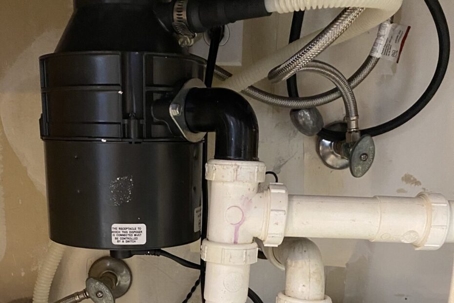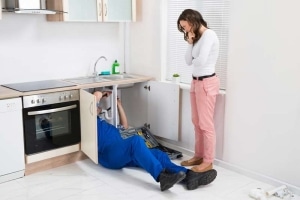Everybody maintains their own assumption in relation to Tips on Fixing a Leaking Garbage Disposal.

Waste disposal unit are important cooking area appliances that assist in dealing with food waste successfully. However, a leaking waste disposal unit can be an irritating and unpleasant trouble to deal with. Thankfully, numerous leaks can be taken care of conveniently with a couple of basic steps. In this write-up, we will talk about exactly how to deal with a dripping waste disposal unit properly.
Intro
Waste disposal unit are mounted under cooking area sinks and are created to shred food waste into smaller sized pieces, allowing it to travel through the plumbing system easily. While these tools are generally trusted, leaks can happen over time due to deterioration, loosened connections, or damages to the system.
Common Causes of Leaks in Rubbish Disposals
Worn Seals and Gaskets
Seals and gaskets play an essential duty in avoiding water from dripping out of the waste disposal unit. Over time, these elements can wear away, resulting in leakages around the disposal device.
Loose Links
The links between the garbage disposal and the pipes system can come to be loose in time, causing water to leak out during procedure.
Fractures or Openings in the Disposal Device
Physical damages to the waste disposal unit, such as fractures or holes in the housing, can additionally cause leakages.
Identifying the Resource of the Leakage
Before attempting to take care of a dripping waste disposal unit, it is important to determine the resource of the leakage. This can generally be done with visual assessment or by performing straightforward examinations.
Visual Examination
Inspect the waste disposal unit unit carefully for any indicators of water leak. Pay attention to areas around seals, gaskets, and connection points.
Evaluating for Leaks
One method to check for leakages is by running water via the disposal device and looking for any noticeable indicators of leakage.
Tools and Materials Needed for Fixing a Dripping Garbage Disposal
Before starting the fixing procedure, gather the necessary devices and products, including a screwdriver, adjustable wrench, plumbing technician's putty, replacement seals or gaskets, and epoxy or patching material for fixing splits or holes.
Step-by-Step Overview to Taking Care Of a Leaking Waste Disposal Unit
Shut off the Power
Prior to attempting any kind of repair work, make sure that the power to the garbage disposal device is switched off to stop the danger of electric shock.
Find the Leakage
Identify the precise place of the leakage and figure out the cause.
Tighten up Links
Make use of a wrench to tighten up any kind of loose connections in between the disposal device and the pipes system.
Change Seals or Gaskets
If the leak results from worn seals or gaskets, eliminate the old parts and replace them with new ones.
Patching Fractures or Openings
For splits or openings in the disposal device, usage epoxy or a suitable patching material to seal the damaged area.
Checking the Waste Disposal Unit After Repair
When the repair is total, evaluate the waste disposal unit by running water through it to make sure that the leak has been settled.
Preventive Maintenance Tips to Stay Clear Of Future Leaks
To prevent future leaks, it is important to do routine upkeep on your waste disposal unit. This consists of keeping it tidy, staying clear of placing non-food products or hard objects down the disposal, and regularly checking for leakages or various other issues.
Final thought
In conclusion, repairing a dripping waste disposal unit is a fairly uncomplicated process that can be finished with standard devices and products. By following the steps detailed in this write-up and practicing preventive upkeep, you can keep your waste disposal unit in good working condition and stay clear of expensive repairs in the future.
HERE’S HOW TO FIX YOUR GARBAGE DISPOSAL
WHAT TO DO IF SOMETHING IS STUCK IN YOUR GARBAGE DISPOSAL
If the impeller won’t turn, there’s probably something stuck in the disposal. It could be a steak bone or peach pit, although plumbers report pulling all sorts of inappropriate objects out of disposals, such as bottle caps or aluminum foil. Make sure power to the disposal is off, and look inside to see if you can see the source of the jam.
Never stick your fingers in a disposal. Pull out anything you see with tongs or pliers.
If the disposal still won’t work, it may be time to call a plumber or consider buying a new disposal. GEM Plumbing & Heating is here for all of your garbage disposal needs.
WHAT TO DO IF YOUR GARBAGE DISPOSAL DRAIN IS CLOGGED
Take everything out from underneath your sink and put a bucket or other container under your disposal to catch any water that drains out. Disconnect your disposal from the power supply. If it’s plugged into a wall outlet, unplug it. If it’s hardwired into an electrical box, go to the electrical panel and turn off the breaker for the disposal. Pour ¼ cup of baking soda into the drain, followed by ½ cup of white vinegar. Give the solution a few minutes to fizz and do its work. Look into the disposal with a flashlight to see if you can see an object that might be causing the clog. If you see it, remove it using tongs or pliers. MORE TIPS ON DEALING WITH A CLOGGED GARBAGE DISPOSAL
Never use drain cleaner in a garbage disposal. It can damage the plastic parts inside the disposal. You can also be splashed with the caustic liquid while working to clear the clog. Beware! Never stick your fingers into a garbage disposal. Trust us — not a good idea. In many instances, your dishwasher drains through your garbage disposal. This allows the disposal to grind any large food particles that may be drained out of your dishwasher. There are some jurisdictions, however, where the plumbing code prohibits such a connection. WHAT TO DO WHEN YOUR DISHWASHER DRAINS THROUGH THE DISPOSAL
Run some water in the sink so your plunger has at least a ½-inch of water to create a seal and plunge vigorously up and down several times. You may need to repeat this several times. Run hot water down the drain to clear any residue that remains.

Do you like more info about Why Is ? Leave a short review further down. We'd be delighted to hear your views about this review. Hoping that you come back again soon. Feel free to take the opportunity to promote this blog if you enjoyed it. I value reading our article about Why Is My Garbage Disposal Leaking From the Bottom?.
Go Deal